For our tour description, itinerary,
past triplists, dates, fees, and more, please VISIT OUR TOUR PAGE.
See this triplist in printable PDF format with media only on
page 1.

Andean
Cock-of-the-Rock is not a Colombian specialty, but seeing it
like this is special--at an afternoon lek within walking
distance of town! (Photo by guide Richard Webster)
The Andes of Colombia are amazing, as we saw repeatedly as we
crisscrossed the Cauca Valley going from one birding spot to
another. Steep, wet, green, rugged, even with a bit of snow on
top. Our journey took us from 3,000' to over 13,000' in the
Central and Western Andes, through different belts of forest
to above treeline.
And yes, there were some birds along the way, certainly
including a good number of endemics, but also many regional
specialties and seldom-seen birds, as well as a terrific
assortment of Andean species. For instance, Andean
Cock-of-the-Rock is hardly a Colombian specialty, but the lek
we visited one afternoon, within walking distance of a town
square, was as easy and as pleasant a way to view this
spectacular bird as one could want.
Our trip started at RNA (Reserva Natural de las Aves)
Arrierito Antioquena (the Piha reserve), ProAves' lodge and
reserve at the northern end of the Central Andes. Birding was
slow, but we steadily found more and more, including the
flagship Chestnut-capped Piha, Red-bellied Grackle,
Multicolored Tanager, and Parker's Antbird, along with some
fine skulkers, including Sooty-headed Wren and
Chestnut-crowned Gnateater. Between birding forays we greatly
enjoyed the fine feeders, and on the way out we had a last
minute save on White-mantled Barbet.
Moving to the Western Andes, we visited Jardin, where our
principal quarry was the endangered Yellow-eared Parrot, of
which we saw many, although few close, and none in the dream
setting of feeding right next to us. Many other forest birds
were along the way back, including fine Tanager Finches
(always a difficult skulker), Glowing Puffleg, Powerful
Woodpecker, and Tyrannine Woodcreeper. Shifting to the Pacific
slope, we next visited RNA Las Tangaras, where the new lodge
was a nice base for our first visit to the middle elevations
of the Choco, an endemic-rich region shared with Ecuador.
Birding along a remote track and good trail produced many
specialties, including Black-and-gold Tanager, Black
Solitaire, Choco Vireo, Indigo Flower-piercer, and Toucan
Barbet, along with an undescribed tapaculo, and several fun
flocks and fruiting trees. Birding downslope produced a few
more new ones, along with a real rarity, a Red-tailed Hawk.
Heading south and into the Central Andes, we spent two nights
at Rio Blanco, a watershed reserve for the city of Manizales.
Our lodge was ringed with hummingbird feeders for constant
beauty and entertainment, and allowed us to bird on foot for
the next day and a half. We did wonderfully well with the
antpittas, five species of which came for food (more than are
typically reliable), including Brown-banded, Bicolored, and
Chestnut-naped. Some of the other special birds were
Rusty-faced Parrot, Golden-plumed Parakeet, Masked Saltator,
Dusky Piha, Black-collared Jay, and Red-hooded Tanager, and
the overall activity level was excellent. After a night down
in town we headed for the paramo of P.N. Los Nevados, where
the weather was 'in between' but not so bad as to prevent us
from seeing some lovely mountain-tanagers and great
hummingbirds, including the prize Bearded Helmetcrest and
lovely Rainbow-bearded Thornbill. A great showing by Tawny
Antpitta was also enjoyed (in your face and in your ear).
En route to Otun-Quimbaya Sanctuary, a small wetland produced
a Ring-necked Duck and 13 Lesser Scaup, surprises this far
south. Otun-Quimbaya lived up to its reputation for numbers of
Cauca Guans and Red-ruffed Fruitcrows, and while Chestnut
Wood-Quails remained unseen, we did find many other birds,
including more Crested Ant-Tanagers. A zig across the Cauca
brought us back to the Western Andes and the Choco on Cerro
Montezuma, where we greatly enjoyed the hospitality of
Leopoldina and her daughters in order to access the P.N.
Tatama. There we connected with Munchique Wood-Wren at close
range and found the lovely Gold-ringed Tanager nearby.
Continued birding along the forested track was rich in birds
of the montane Choco, including Uniform Treehunter,
Fulvous-dotted Treerunner, Club-winged Manakin, a brief
Scarlet-and-white Tanager, a second chance on Multicolored
Tanager, Glistening-green Tanager, and Black-chinned
Mountain-Tanager, as well as some more widespread specialties,
such as two quetzals and two trogons, Olivaceous Piha, and
Olive Finch. Our trip concluded with the flooded marshes near
Buga, now inaccessible, but a nearby reserve provided an
alternative for Apical Flycatcher, a second encounter with
Grayish Piculet, Spectacled Parrotlet, Jet Antbird, and
Slate-headed Tody-Flycatcher.
Our travel through Colombia was made easy by Daniel's
arrangements and Olegario's steady hand behind the wheel.
Local birders helped us at several stops (thanks Jose,
Gustavo, Uberney, and Alveiro). Apologies to the Spanish
language--we avoid some punctuation and accents that do not
translate well across our various computer platforms. Taxonomy
largely follows the latest updates to Clements (Cornell).
Conservation status is drawn from the various publications of
BirdLife International.
--Richard
KEYS FOR THIS LIST
One of the following keys may be shown in brackets for
individual species as appropriate: * = heard only, I =
introduced, E = endemic, N = nesting, a = austral migrant, b =
boreal migrant
Tinamidae (Tinamous)
LITTLE TINAMOU (Crypturellus soui) [*]
Anatidae (Ducks, Geese, and Waterfowl)
BLACK-BELLIED WHISTLING-DUCK (Dendrocygna autumnalis)
FULVOUS
WHISTLING-DUCK (Dendrocygna
bicolor)
BLUE-WINGED TEAL
(Anas discors) [b]
CINNAMON TEAL
(Anas cyanoptera)
RING-NECKED DUCK
(Aythya collaris) [b]
LESSER SCAUP
(Aythya affinis) [b]
RUDDY DUCK
(ANDEAN) (Oxyura jamaicensis
ferruginea)
Cracidae (Guans, Chachalacas, and
Curassows)
COLOMBIAN CHACHALACA (Ortalis columbiana) [E]
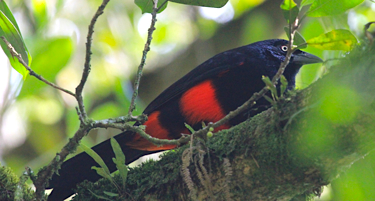
Red-bellied
Grackle is an Endangered species with a limited range in
the Central and Western Andes of Colombia. Flocks of this
forest grackle range widely through the forest, but
fortunately call loudly, giving us a chance to locate
them. (Photo by guide Richard Webster)
CAUCA GUAN (Penelope
perspicax) [E]
WATTLED GUAN
(Aburria aburri) [*]
SICKLE-WINGED GUAN
(Chamaepetes goudotii)
Odontophoridae (New World Quail)
CHESTNUT WOOD-QUAIL (Odontophorus hyperythrus) [E*]
Podicipedidae (Grebes)
LEAST GREBE (Tachybaptus dominicus)
PIED-BILLED GREBE
(Podilymbus podiceps)
Phalacrocoracidae (Cormorants and Shags)
NEOTROPIC CORMORANT (Phalacrocorax brasilianus)
Anhingidae (Anhingas)
ANHINGA (Anhinga
anhinga)
Ardeidae (Herons, Egrets, and Bitterns)
FASCIATED TIGER-HERON (Tigrisoma fasciatum)
COCOI HERON
(Ardea cocoi)
GREAT EGRET
(Ardea alba)
SNOWY EGRET
(Egretta thula)
LITTLE BLUE HERON
(Egretta caerulea)
CATTLE EGRET
(Bubulcus ibis)
STRIATED HERON
(Butorides striata)
BLACK-CROWNED
NIGHT-HERON (Nycticorax
nycticorax)
Threskiornithidae (Ibises and Spoonbills)
GLOSSY IBIS (Plegadis falcinellus)
BARE-FACED IBIS
(Phimosus infuscatus)
BUFF-NECKED IBIS
(Theristicus caudatus) [*]
Cathartidae (New World Vultures)
BLACK VULTURE (Coragyps atratus)
TURKEY VULTURE
(Cathartes aura)
Pandionidae (Osprey)
OSPREY (Pandion
haliaetus)
[b]
Accipitridae (Hawks, Eagles, and Kites)
SWALLOW-TAILED KITE (Elanoides forficatus)
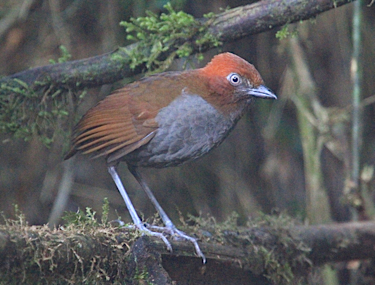
Chestnut-naped
Antpitta is not a regular customer for worms at Rio
Blanco, but we were lucky to have two come in (which then
fought in the bushes over the territory). (Photo by guide
Richard Webster)
PEARL KITE (Gampsonyx
swainsonii)
SNAIL KITE
(Rostrhamus sociabilis)
SHARP-SHINNED HAWK
(PLAIN-BREASTED) (Accipiter
striatus ventralis)
SAVANNA HAWK
(Buteogallus meridionalis)
ROADSIDE HAWK
(Buteo magnirostris)
BROAD-WINGED HAWK
(Buteo platypterus) [b]
SHORT-TAILED HAWK
(Buteo brachyurus)
RED-TAILED HAWK
(Buteo jamaicensis)
BLACK HAWK-EAGLE
(Spizaetus tyrannus)
Falconidae (Falcons and Caracaras)
CRESTED CARACARA (Caracara cheriway)
YELLOW-HEADED
CARACARA (Milvago chimachima
chimachima)
AMERICAN KESTREL
(Falco sparverius)
Rallidae (Rails, Gallinules, and Coots)
WHITE-THROATED CRAKE (Laterallus albigularis)
GRAY-NECKED
WOOD-RAIL (Aramides cajanea)
[*]
RUSSET-CROWNED
CRAKE (Anurolimnas viridis)
[*]
BLACKISH RAIL
(Pardirallus nigricans)
COMMON GALLINULE
(Gallinula galeata)
AMERICAN COOT
(Fulica americana)
Aramidae (Limpkin)
LIMPKIN (Aramus
guarauna)
Charadriidae (Plovers and Lapwings)
SOUTHERN LAPWING (Vanellus chilensis)
Jacanidae (Jacanas)
WATTLED JACANA (Jacana jacana)
Scolopacidae (Sandpipers and Allies)
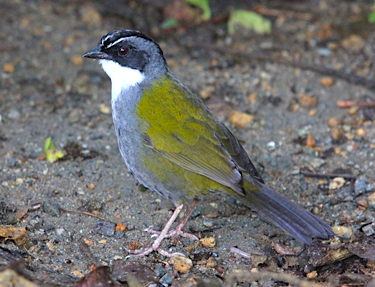
Gray-browed
Brush-Finch has learned that the antpitta feeding area at
Rio Blanco is a good foraging ground for it, too;
Gray-browed is a recent split of the "Stripe-headed"
group. (Photo by guide Richard Webster)
SPOTTED SANDPIPER (Actitis macularius) [b]
SOLITARY SANDPIPER
(Tringa solitaria)
[b]
GREATER YELLOWLEGS
(Tringa melanoleuca) [b]
LESSER YELLOWLEGS
(Tringa flavipes) [b]
Columbidae (Pigeons and Doves)
ROCK PIGEON (Columba livia) [I]
PALE-VENTED PIGEON
(Patagioenas cayennensis)
BAND-TAILED PIGEON
(WHITE-NECKED) (Patagioenas
fasciata albilinea)
PLUMBEOUS PIGEON
(Patagioenas plumbea chapmani)
RUDDY PIGEON
(Patagioenas subvinacea)
DUSKY PIGEON
(Patagioenas goodsoni)
EARED DOVE
(Zenaida auriculata)
RUDDY GROUND-DOVE
(Columbina talpacoti)
WHITE-TIPPED DOVE
(Leptotila verreauxi)
WHITE-THROATED
QUAIL-DOVE (Geotrygon frenata)
Psittacidae (Parrots)
GOLDEN-PLUMED PARAKEET (Leptosittaca branickii)
SCARLET-FRONTED
PARAKEET (Aratinga wagleri
wagleri)
YELLOW-EARED
PARROT (Ognorhynchus
icterotis)
SPECTACLED
PARROTLET (Forpus
conspicillatus)
BLUE-FRONTED
PARROTLET (Touit
dilectissimus)
[*]
RUSTY-FACED PARROT
(Hapalopsittaca amazonina)
BLUE-HEADED PARROT
(Pionus menstruus)
BRONZE-WINGED
PARROT (Pionus chalcopterus)
SCALY-NAPED PARROT
(Amazona mercenaria)
Cuculidae (Cuckoos)
SQUIRREL CUCKOO (Piaya cayana)
SMOOTH-BILLED ANI
(Crotophaga ani)
Strigidae (Owls)
TROPICAL SCREECH-OWL (Megascops choliba) [*]
WHITE-THROATED
SCREECH-OWL (Megascops
albogularis)
ANDEAN PYGMY-OWL
(Glaucidium jardinii) [*]
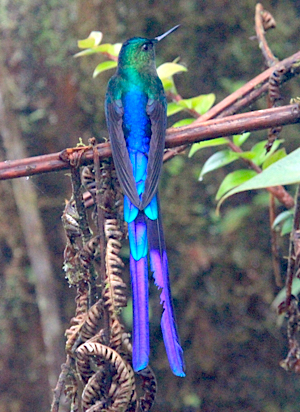
The stunning
Violet-tailed Sylph is the Choco representative of the
Sylph group. Feeders provide terrific views of this beauty
both in Colombia and Ecuador. (Photo by guide Richard
Webster)
RUFOUS-BANDED OWL (Ciccaba albitarsis) [*]
Caprimulgidae (Nightjars and Allies)
COMMON NIGHTHAWK (Chordeiles minor) [b]
COMMON PAURAQUE
(Nyctidromus albicollis) [*]
Apodidae (Swifts)
CHESTNUT-COLLARED SWIFT (Streptoprocne rutila)
WHITE-COLLARED
SWIFT (Streptoprocne zonaris)
LESSER
SWALLOW-TAILED SWIFT (Panyptila
cayennensis)
Trochilidae (Hummingbirds)
WHITE-NECKED JACOBIN (Florisuga mellivora)
WHITE-TIPPED
SICKLEBILL (Eutoxeres aquila)
GREEN HERMIT
(Phaethornis guy)
TAWNY-BELLIED
HERMIT (Phaethornis
syrmatophorus)
GREEN-FRONTED
LANCEBILL (Doryfera ludovicae)
[N]
WEDGE-BILLED
HUMMINGBIRD (Schistes
geoffroyi)
GREEN VIOLETEAR
(Colibri thalassinus)
BLACK-THROATED
MANGO (Anthracothorax
nigricollis)
TOURMALINE
SUNANGEL (Heliangelus exortis)
SPECKLED
HUMMINGBIRD (Adelomyia
melanogenys)
LONG-TAILED SYLPH
(Aglaiocercus kingi)
VIOLET-TAILED
SYLPH (Aglaiocercus coelestis)
RAINBOW-BEARDED
THORNBILL (Chalcostigma
herrani)
BEARDED
HELMETCREST (Oxypogon
guerinii)
VIRIDIAN METALTAIL
(Metallura williami)
GREENISH PUFFLEG
(Haplophaedia aureliae)
GLOWING PUFFLEG
(Eriocnemis vestita paramillo)
GOLDEN-BREASTED
PUFFLEG (Eriocnemis mosquera)
BROWN INCA
(Coeligena wilsoni)
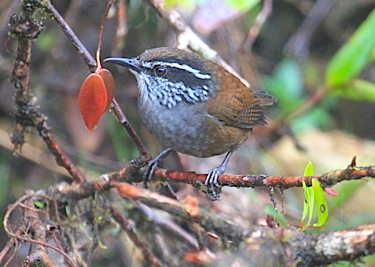
Munchique
Wood-Wren is a recently-described species from Colombia's
Andes, and a skulking and local one with which we were
lucky in 2012 on Cerro Montezuma in Parque Nacional
Tatamá. (Photo by guide Richard Webster)
COLLARED INCA (Coeligena torquata)
MOUNTAIN
VELVETBREAST (Lafresnaya
lafresnayi)
BUFF-TAILED
CORONET (Boissonneaua
flavescens)
VELVET-PURPLE
CORONET (Boissonneaua jardini)
BOOTED RACKET-TAIL
(Ocreatus underwoodii)
WHITE-TAILED
HILLSTAR (Urochroa bougueri)
PURPLE-BIBBED
WHITETIP (Urosticte benjamini)
FAWN-BREASTED
BRILLIANT (Heliodoxa
rubinoides)
GREEN-CROWNED
BRILLIANT (Heliodoxa jacula)
EMPRESS BRILLIANT
(Heliodoxa imperatrix)
WHITE-BELLIED
WOODSTAR (Chaetocercus
mulsant)
PURPLE-THROATED
WOODSTAR (Calliphlox
mitchellii)
WESTERN EMERALD
(Chlorostilbon melanorhynchus
melanorhynchus)
GREEN-CROWNED
WOODNYMPH (Thalurania fannyi)
ANDEAN EMERALD
(Amazilia franciae)
STEELY-VENTED
HUMMINGBIRD (Amazilia
saucerrottei)
RUFOUS-TAILED
HUMMINGBIRD (Amazilia tzacatl)
BLUE-HEADED
SAPPHIRE (Hylocharis grayi)
Trogonidae (Trogons)
GOLDEN-HEADED QUETZAL (Pharomachrus auriceps)
CRESTED QUETZAL
(Pharomachrus antisianus)
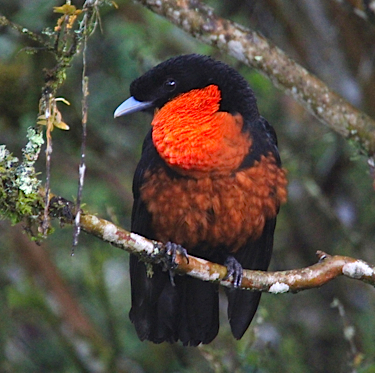
Red-ruffed
Fruitcrow is widespread in South America, but local and
found on few tour routes. Otun-Quimbaya sanctuary in the
Central Andes is dynamite for them. This one was "hunting"
the wily fallen fruit right outside of our rooms. (Photo
by guide Richard Webster)
COLLARED TROGON (Trogon collaris)
MASKED TROGON
(Trogon personatus assimilis)
MASKED TROGON
(Trogon personatus temperatus)
Momotidae (Motmots)
ANDEAN MOTMOT (Momotus aequatorialis)
BROAD-BILLED
MOTMOT (Electron
platyrhynchum)
Alcedinidae (Kingfishers)
RINGED KINGFISHER (Megaceryle torquata)
AMAZON KINGFISHER
(Chloroceryle amazona)
GREEN KINGFISHER
(Chloroceryle americana)
Bucconidae (Puffbirds)
MOUSTACHED PUFFBIRD (Malacoptila mystacalis)
Capitonidae (New World Barbets)
WHITE-MANTLED BARBET (Capito hypoleucus) [E]
RED-HEADED BARBET
(Eubucco bourcierii)
Semnornithidae (Toucan-Barbets)
TOUCAN BARBET (Semnornis ramphastinus)
Ramphastidae (Toucans)
EMERALD TOUCANET (Aulacorhynchus prasinus)
CRIMSON-RUMPED
TOUCANET (Aulacorhynchus
haematopygus)
BLACK-BILLED
MOUNTAIN-TOUCAN (Andigena
nigrirostris)
Picidae (Woodpeckers)
GRAYISH PICULET (Picumnus granadensis) [E]
RED-CROWNED
WOODPECKER (Melanerpes
rubricapillus)
YELLOW-VENTED
WOODPECKER (Veniliornis
dignus)
GOLDEN-OLIVE
WOODPECKER (Colaptes
rubiginosus)
CRIMSON-MANTLED
WOODPECKER (Colaptes rivolii)
POWERFUL
WOODPECKER (Campephilus
pollens)
Furnariidae (Ovenbirds and Woodcreepers)
STOUT-BILLED CINCLODES (Cinclodes excelsior)
ANDEAN
TIT-SPINETAIL (Leptasthenura
andicola)
AZARA'S SPINETAIL
(Synallaxis azarae)
PALE-BREASTED
SPINETAIL (Synallaxis
albescens)
RUFOUS SPINETAIL
(Synallaxis unirufa) [*]
SLATY SPINETAIL
(Synallaxis brachyura)
RED-FACED
SPINETAIL (Cranioleuca
erythrops) [N]
WHITE-CHINNED
THISTLETAIL (Asthenes
fuliginosa)
SPOTTED BARBTAIL
(Premnoplex brunnescens)
FULVOUS-DOTTED
TREERUNNER (Margarornis
stellatus)
PEARLED TREERUNNER
(Margarornis squamiger)
BUFFY TUFTEDCHEEK
(Pseudocolaptes lawrencii)
SCALY-THROATED
FOLIAGE-GLEANER (Anabacerthia
variegaticeps)
MONTANE
FOLIAGE-GLEANER (Anabacerthia
striaticollis)
LINEATED
FOLIAGE-GLEANER (Syndactyla
subalaris)
BUFF-FRONTED
FOLIAGE-GLEANER (Philydor
rufum)
UNIFORM TREEHUNTER
(Thripadectes ignobilis)
STRIPED TREEHUNTER
(Thripadectes holostictus)
STREAK-CAPPED
TREEHUNTER (Thripadectes
virgaticeps)
RUDDY
FOLIAGE-GLEANER (Automolus
rubiginosus)
STREAKED XENOPS
(Xenops rutilans)
TYRANNINE
WOODCREEPER (Dendrocincla
tyrannina)
WEDGE-BILLED
WOODCREEPER (Glyphorynchus
spirurus)
STRONG-BILLED
WOODCREEPER (Xiphocolaptes
promeropirhynchus)
COCOA WOODCREEPER
(Xiphorhynchus susurrans)
OLIVE-BACKED
WOODCREEPER (Xiphorhynchus
triangularis)
STREAK-HEADED
WOODCREEPER (Lepidocolaptes
souleyetii)
MONTANE
WOODCREEPER (Lepidocolaptes
lacrymiger)
Thamnophilidae (Typical Antbirds)
BAR-CRESTED ANTSHRIKE (Thamnophilus multistriatus)
UNIFORM ANTSHRIKE
(Thamnophilus unicolor)
PLAIN ANTVIREO
(Dysithamnus mentalis)
SLATY ANTWREN
(Myrmotherula schisticolor)
YELLOW-BREASTED
ANTWREN (Herpsilochmus
axillaris)
LONG-TAILED
ANTBIRD (Drymophila caudata)
[*]
RUFOUS-RUMPED
ANTWREN (Terenura callinota)
PARKER'S ANTBIRD
(Cercomacra parkeri) [E]
JET ANTBIRD
(Cercomacra nigricans)
Formicariidae (Antthrushes)
RUFOUS-BREASTED ANTTHRUSH (Formicarius rufipectus) [*]
Grallariidae (Antpittas)
MOUSTACHED ANTPITTA (Grallaria alleni) [*]
PLAIN-BACKED
ANTPITTA (Grallaria haplonota)
[*]
CHESTNUT-CROWNED
ANTPITTA (Grallaria
ruficapilla)
BICOLORED ANTPITTA
(Grallaria rufocinerea)
CHESTNUT-NAPED
ANTPITTA (Grallaria nuchalis)
YELLOW-BREASTED
ANTPITTA (Grallaria
flavotincta) [*]
WHITE-BELLIED
ANTPITTA (Grallaria hypoleuca)
[*]
RUFOUS ANTPITTA
(Grallaria rufula)
[*]
TAWNY ANTPITTA
(Grallaria quitensis)
BROWN-BANDED
ANTPITTA (Grallaria milleri)
[E]
OCHRE-BREASTED
ANTPITTA (Grallaricula
flavirostris)
SLATE-CROWNED
ANTPITTA (Grallaricula nana)
Conopophagidae (Gnateaters)
CHESTNUT-CROWNED GNATEATER (Conopophaga castaneiceps)
Rhinocryptidae (Tapaculos)
OCELLATED TAPACULO (Acropternis orthonyx) [*]
ASH-COLORED
TAPACULO (Myornis senilis)
BLACKISH TAPACULO
(Scytalopus latrans)
WHITE-CROWNED
TAPACULO (Scytalopus atratus
confusus)
CHOCO TAPACULO
(Scytalopus chocoensis) [*]
STILES'S TAPACULO
(Scytalopus stilesi)
[E]
NARINO TAPACULO
(Scytalopus vicinior)
SPILLMANN'S
TAPACULO (Scytalopus
spillmanni)
PARAMO TAPACULO
(Scytalopus opacus)
[*]
TAPACULO (NEW
SPECIES) (Scytalopus sp. nov.
1)
Tyrannidae (Tyrant Flycatchers)
WHITE-TAILED TYRANNULET (Mecocerculus poecilocercus)
WHITE-BANDED
TYRANNULET (Mecocerculus
stictopterus)
WHITE-THROATED
TYRANNULET (Mecocerculus
leucophrys)
YELLOW-CROWNED
TYRANNULET (Tyrannulus elatus)
GREENISH ELAENIA
(Myiopagis viridicata)
YELLOW-BELLIED
ELAENIA (Elaenia flavogaster)
MOUNTAIN ELAENIA
(Elaenia frantzii)
TORRENT TYRANNULET
(Serpophaga cinerea)
STREAK-NECKED
FLYCATCHER (Mionectes
striaticollis)
OLIVE-STRIPED
FLYCATCHER (Mionectes
olivaceus)
OCHRE-BELLIED
FLYCATCHER (Mionectes
oleagineus)
SLATY-CAPPED
FLYCATCHER (Leptopogon
superciliaris)
RUFOUS-BREASTED
FLYCATCHER (Leptopogon
rufipectus)
VARIEGATED
BRISTLE-TYRANT (Phylloscartes
poecilotis)
MARBLE-FACED
BRISTLE-TYRANT (Phylloscartes
ophthalmicus)
RUFOUS-BROWED
TYRANNULET (Phylloscartes
superciliaris)
BLACK-CAPPED
TYRANNULET (Phyllomyias
nigrocapillus)
PLUMBEOUS-CROWNED
TYRANNULET (Phyllomyias
plumbeiceps)
GOLDEN-FACED
TYRANNULET (GOLDEN-FACED) (Zimmerius
chrysops chrysops)
ORNATE FLYCATCHER
(Myiotriccus ornatus)
BLACK-CAPPED
PYGMY-TYRANT (Myiornis
atricapillus)
SCALE-CRESTED
PYGMY-TYRANT (Lophotriccus
pileatus)
RUFOUS-CROWNED
TODY-FLYCATCHER (Poecilotriccus
ruficeps)
SLATE-HEADED
TODY-FLYCATCHER (Poecilotriccus
sylvia)
COMMON
TODY-FLYCATCHER (Todirostrum
cinereum)
[N]
FULVOUS-BREASTED
FLATBILL (Rhynchocyclus
fulvipectus)
YELLOW-OLIVE
FLYCATCHER (Tolmomyias
sulphurescens)
CINNAMON
FLYCATCHER (Pyrrhomyias
cinnamomeus)
HANDSOME
FLYCATCHER (Nephelomyias
pulcher)
FLAVESCENT
FLYCATCHER (Myiophobus
flavicans)
BRAN-COLORED
FLYCATCHER (Myiophobus
fasciatus)
SMOKE-COLORED
PEWEE (Contopus fumigatus)
EASTERN WOOD-PEWEE
(Contopus virens) [b]
ACADIAN FLYCATCHER
(Empidonax virescens) [b]
BLACK PHOEBE
(Sayornis nigricans)
VERMILION
FLYCATCHER (Pyrocephalus
rubinus)
STREAK-THROATED
BUSH-TYRANT (Myiotheretes
striaticollis)
SMOKY BUSH-TYRANT
(Myiotheretes fumigatus)
PIED WATER-TYRANT
(Fluvicola pica)
CROWNED
CHAT-TYRANT (Ochthoeca
frontalis)
SLATY-BACKED
CHAT-TYRANT (Ochthoeca
cinnamomeiventris)
BROWN-BACKED
CHAT-TYRANT (Ochthoeca
fumicolor)
CATTLE TYRANT
(Machetornis rixosa)
DUSKY-CAPPED
FLYCATCHER (Myiarchus
tuberculifer)
APICAL FLYCATCHER
(Myiarchus apicalis) [E]
PALE-EDGED
FLYCATCHER (Myiarchus
cephalotes)
GREAT KISKADEE
(Pitangus sulphuratus)
RUSTY-MARGINED
FLYCATCHER (Myiozetetes
cayanensis)
LEMON-BROWED
FLYCATCHER (Conopias
cinchoneti) [*]
GOLDEN-CROWNED
FLYCATCHER (Myiodynastes
chrysocephalus)
STREAKED
FLYCATCHER (Myiodynastes
maculatus) [N]
TROPICAL KINGBIRD
(Tyrannus melancholicus)
FORK-TAILED
FLYCATCHER (Tyrannus savana)
Cotingidae (Cotingas)
GREEN-AND-BLACK FRUITEATER (Pipreola riefferii)
ORANGE-BREASTED
FRUITEATER (Pipreola jucunda)
RED-CRESTED
COTINGA (Ampelion
rubrocristatus)
ANDEAN
COCK-OF-THE-ROCK (Rupicola
peruvianus)
OLIVACEOUS PIHA
(Snowornis cryptolophus)
RED-RUFFED
FRUITCROW (Pyroderus scutatus)
CHESTNUT-CAPPED
PIHA (Lipaugus weberi)
[E]
DUSKY PIHA
(Lipaugus fuscocinereus)
Pipridae (Manakins)
GOLDEN-WINGED MANAKIN (Masius chrysopterus)
CLUB-WINGED
MANAKIN (Machaeropterus
deliciosus)
WHITE-BEARDED
MANAKIN (Manacus manacus)
[*]
WING-BARRED
PIPRITES (Piprites chloris)
[*]
Tityridae (Tityras and Allies)
BARRED BECARD (Pachyramphus versicolor)
CINEREOUS BECARD
(Pachyramphus rufus)
WHITE-WINGED
BECARD (Pachyramphus
polychopterus)
Vireonidae (Vireos)
CHOCO VIREO (Vireo masteri)
BROWN-CAPPED VIREO
(Vireo leucophrys)
RED-EYED VIREO
(Vireo olivaceus)
RUFOUS-NAPED
GREENLET (Hylophilus
semibrunneus)
BLACK-BILLED
PEPPERSHRIKE (Cyclarhis
nigrirostris)
Corvidae (Crows, Jays, and Magpies)
BLACK-COLLARED JAY (Cyanolyca armillata)
BLACK-CHESTED JAY
(Cyanocorax affinis)
GREEN JAY (Cyanocorax yncas)
Hirundinidae (Swallows)
BLUE-AND-WHITE SWALLOW (Pygochelidon cyanoleuca)
BROWN-BELLIED
SWALLOW (Orochelidon murina)
SOUTHERN
ROUGH-WINGED SWALLOW (Stelgidopteryx
ruficollis)
GRAY-BREASTED
MARTIN (Progne chalybea)
BARN SWALLOW
(Hirundo rustica) [b]
Troglodytidae (Wrens)
WHITE-HEADED WREN (Campylorhynchus albobrunneus)
RUFOUS WREN
(Cinnycerthia unirufa)
SHARPE'S WREN
(Cinnycerthia olivascens)
SOOTY-HEADED WREN
(Pheugopedius spadix)
WHISKERED WREN
(Pheugopedius mystacalis)
BAY WREN (Cantorchilus nigricapillus)
HOUSE WREN
(SOUTHERN) (Troglodytes aedon
musculus)
MOUNTAIN WREN
(Troglodytes solstitialis)
SEDGE WREN
(Cistothorus platensis)
GRAY-BREASTED
WOOD-WREN (Henicorhina
leucophrys)
MUNCHIQUE
WOOD-WREN (Henicorhina
negreti) [E]
SCALY-BREASTED
WREN (Microcerculus
marginatus) [*]
CHESTNUT-BREASTED
WREN (Cyphorhinus thoracicus)
[*]
Cinclidae (Dippers)
WHITE-CAPPED DIPPER (Cinclus leucocephalus)
Turdidae (Thrushes and Allies)
ANDEAN SOLITAIRE (Myadestes ralloides)
ORANGE-BILLED
NIGHTINGALE-THRUSH (Catharus
aurantiirostris) [*]
GRAY-CHEEKED
THRUSH (Catharus minimus)
[b]
SWAINSON'S THRUSH
(Catharus ustulatus) [b]
BLACK SOLITAIRE
(Entomodestes coracinus)
PALE-EYED THRUSH
(Turdus leucops)
BLACK-BILLED
THRUSH (Turdus ignobilis)
GREAT THRUSH
(Turdus fuscater)
GLOSSY-BLACK
THRUSH (Turdus serranus)
Parulidae (New World Warblers)
NORTHERN WATERTHRUSH (Parkesia noveboracensis) [b]
BLACK-AND-WHITE
WARBLER (Mniotilta varia)
[b]
TENNESSEE WARBLER
(Oreothlypis peregrina) [b]
OLIVE-CROWNED
YELLOWTHROAT (Geothlypis
semiflava)
TROPICAL PARULA
(Setophaga pitiayumi)
BAY-BREASTED
WARBLER (Setophaga castanea)
[b]
BLACKBURNIAN
WARBLER (Setophaga fusca)
[b]
YELLOW WARBLER
(NORTHERN) (Setophaga petechia
aestiva) [b]
THREE-STRIPED
WARBLER (Basileuterus
tristriatus)
CITRINE WARBLER
(Myiothlypis luteoviridis quindianus)
CITRINE WARBLER
(Myiothlypis luteoviridis richardsoni)
BUFF-RUMPED
WARBLER (Myiothlypis
fulvicauda)
GOLDEN-BELLIED
WARBLER (CHOCO) (Myiothlypis
chrysogaster chlorophrys)
RUSSET-CROWNED
WARBLER (Myiothlypis
coronatus)
CANADA WARBLER
(Cardellina canadensis) [b]
SLATE-THROATED
REDSTART (Myioborus miniatus)
GOLDEN-FRONTED
REDSTART (Myioborus ornatus)
Coerebidae (Bananaquit)
BANANAQUIT (Coereba
flaveola)
Thraupidae (Tanagers and Allies)
BLACK-FACED TANAGER (Schistochlamys melanopis)
BLACK-CAPPED
HEMISPINGUS (Hemispingus
atropileus)
SUPERCILIARIED
HEMISPINGUS (Hemispingus
superciliaris)
OLEAGINOUS
HEMISPINGUS (Hemispingus
frontalis)
BLACK-EARED
HEMISPINGUS (Hemispingus
melanotis)
GRAY-HOODED BUSH
TANAGER (Cnemoscopus
rubrirostris)
BLUE-BACKED
CONEBILL (Conirostrum
sitticolor)
CAPPED CONEBILL
(Conirostrum albifrons)
PLUSHCAP (Catamblyrhynchus diadema)
BLACK-BACKED BUSH
TANAGER (Urothraupis
stolzmanni)
GUIRA TANAGER
(Hemithraupis guira)
SCARLET-AND-WHITE
TANAGER (Chrysothlypis
salmoni)
DUSKY-FACED
TANAGER (Mitrospingus
cassinii)
TAWNY-CRESTED
TANAGER (Tachyphonus delatrii)
WHITE-LINED
TANAGER (Tachyphonus rufus)
CRIMSON-BACKED
TANAGER (Ramphocelus
dimidiatus)
FLAME-RUMPED
TANAGER (FLAME-RUMPED) (Ramphocelus
flammigerus flammigerus) [E]
FLAME-RUMPED
TANAGER (LEMON-RUMPED) (Ramphocelus
flammigerus icteronotus)
BLUE-GRAY TANAGER
(Thraupis episcopus)
PALM TANAGER
(Thraupis palmarum)
BLUE-CAPPED
TANAGER (Thraupis
cyanocephala)
BLACK-AND-GOLD
TANAGER (Bangsia
melanochlamys) [E]
GOLD-RINGED
TANAGER (Bangsia aureocincta)
[E]
HOODED
MOUNTAIN-TANAGER (Buthraupis
montana)
LACRIMOSE
MOUNTAIN-TANAGER (Anisognathus
lacrymosus)
SCARLET-BELLIED
MOUNTAIN-TANAGER (Anisognathus
igniventris)
BLUE-WINGED
MOUNTAIN-TANAGER (Anisognathus
somptuosus)
BLACK-CHINNED
MOUNTAIN-TANAGER (Anisognathus
notabilis)
GRASS-GREEN
TANAGER (Chlorornis riefferii)
BUFF-BREASTED
MOUNTAIN-TANAGER (Dubusia
taeniata)
PURPLISH-MANTLED
TANAGER (Iridosornis
porphyrocephalus)
GLISTENING-GREEN
TANAGER (Chlorochrysa
phoenicotis)
MULTICOLORED
TANAGER (Chlorochrysa
nitidissima) [E]
EMERALD TANAGER
(Tangara florida)
GOLDEN TANAGER
(Tangara arthus)
SILVER-THROATED
TANAGER (Tangara
icterocephala)
SAFFRON-CROWNED
TANAGER (Tangara
xanthocephala)
FLAME-FACED
TANAGER (Tangara parzudakii)
SPECKLED TANAGER
(Tangara guttata)
RUFOUS-THROATED
TANAGER (Tangara rufigula)
BAY-HEADED TANAGER
(Tangara gyrola)
SCRUB TANAGER
(Tangara vitriolina)
METALLIC-GREEN
TANAGER (Tangara labradorides)
BLUE-NECKED
TANAGER (Tangara cyanicollis)
GOLDEN-HOODED
TANAGER (Tangara larvata)
BERYL-SPANGLED
TANAGER (Tangara nigroviridis)
BLUE-AND-BLACK
TANAGER (Tangara vassorii)
BLACK-CAPPED
TANAGER (Tangara heinei)
GREEN HONEYCREEPER
(Chlorophanes spiza)
PURPLE
HONEYCREEPER (Cyanerpes
caeruleus)
SWALLOW TANAGER
(Tersina viridis)
STREAKED SALTATOR
(Saltator striatipectus)
MASKED SALTATOR
(Saltator cinctus)
BUFF-THROATED
SALTATOR (Saltator maximus)
BLACK-WINGED
SALTATOR (Saltator atripennis)
Emberizidae (Buntings, Sparrows and
Allies)
PLUMBEOUS SIERRA-FINCH (Phrygilus unicolor)
BLUE-BLACK
GRASSQUIT (Volatinia jacarina)
SLATE-COLORED
SEEDEATER (Sporophila
schistacea)
YELLOW-BELLIED
SEEDEATER (Sporophila
nigricollis)
RUDDY-BREASTED
SEEDEATER (Sporophila minuta)
YELLOW-FACED
GRASSQUIT (Tiaris olivaceus)
[*]
DULL-COLORED
GRASSQUIT (Tiaris obscurus)
GLOSSY
FLOWERPIERCER (Diglossa
lafresnayii)
WHITE-SIDED
FLOWERPIERCER (Diglossa
albilatera)
INDIGO
FLOWERPIERCER (Diglossa
indigotica)
MASKED
FLOWERPIERCER (Diglossa
cyanea)
SAFFRON FINCH
(Sicalis flaveola)
WEDGE-TAILED
GRASS-FINCH (Emberizoides
herbicola)
TANAGER FINCH
(Oreothraupis arremonops)
OLIVE FINCH
(Arremon castaneiceps)
GRAY-BROWED
BRUSH-FINCH (Arremon assimilis
assimilis)
BLACK-STRIPED
SPARROW (Arremonops
conirostris)
WHITE-NAPED
BRUSH-FINCH (YELLOW-THROATED) (Atlapetes
albinucha gutturalis)
TRICOLORED
BRUSH-FINCH (CHOCO) (Atlapetes
tricolor crassus)
SLATY BRUSH-FINCH
(Atlapetes schistaceus)
RUFOUS-COLLARED
SPARROW (Zonotrichia capensis)
COMMON
BUSH-TANAGER (Chlorospingus
ophthalmicus)
DUSKY BUSH-TANAGER
(Chlorospingus semifuscus)
YELLOW-THROATED
BUSH-TANAGER (Chlorospingus
flavigularis)
ASHY-THROATED
BUSH-TANAGER (Chlorospingus
canigularis)
Cardinalidae (Cardinals and Allies)
HEPATIC TANAGER (Piranga flava)
SUMMER TANAGER
(Piranga rubra)
[b]
RED-HOODED TANAGER
(Piranga rubriceps)
CRESTED
ANT-TANAGER (Habia cristata)
[E]
OCHRE-BREASTED
TANAGER (Chlorothraupis
stolzmanni)
ROSE-BREASTED
GROSBEAK (Pheucticus
ludovicianus) [b]
Icteridae (Troupials and Allies)
RED-BREASTED BLACKBIRD (Sturnella militaris)
RED-BELLIED
GRACKLE (Hypopyrrhus
pyrohypogaster) [E]
SHINY COWBIRD
(Molothrus bonariensis)
YELLOW-BACKED
ORIOLE (Icterus chrysater)
YELLOW ORIOLE
(Icterus nigrogularis)
YELLOW-BILLED
CACIQUE (Amblycercus
holosericeus)
MOUNTAIN CACIQUE
(Cacicus chrysonotus)
RUSSET-BACKED
OROPENDOLA (Psarocolius
angustifrons)
Fringillidae (Siskins, Crossbills, and
Allies)
THICK-BILLED EUPHONIA (Euphonia laniirostris)
ORANGE-BELLIED
EUPHONIA (Euphonia
xanthogaster)
BLUE-NAPED
CHLOROPHONIA (Chlorophonia
cyanea)
CHESTNUT-BREASTED
CHLOROPHONIA (Chlorophonia
pyrrhophrys)
LESSER GOLDFINCH
(Spinus psaltria)
YELLOW-BELLIED
SISKIN (Spinus xanthogastrus)
COMMON OPOSSUM
(Didelphis marsupialis)
SILVERY-BROWN
BARE-FACE TAMARIN (Saguinus
leucopus) [E]
RED HOWLER MONKEY
(Alouatta seniculus)
BRAZILIAN RABBIT
(Sylvilagus brasiliensis)
RED-TAILED
SQUIRREL (Sciurus granatensis)
WESTERN PYGMY
SQUIRREL (Microsciurus
mimulus)
Other critters included:
a dead Bothrops on the road at RNA Arrierito
a couple of other dead snakes
a live brown snake that departed quickly (not poisonous)
Chucho, the rehab Spectacled Bear
a green Anolis David found on Cerro Montezuma
the Bug on Bob's Arm
the bug that if it it bites you, . . . . (at Lago Calima, and
you had to be there)
some fine butterflies
many lovely moths, especially at Leopoldina's, and especially
that big Cecropia type
Totals for the tour: 430 bird taxa and 6 mammal taxa







